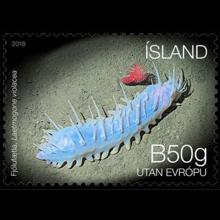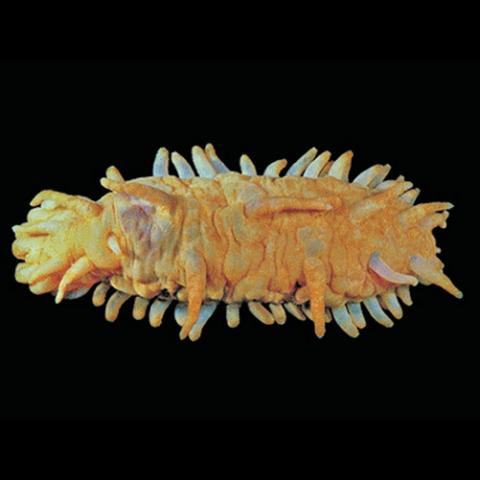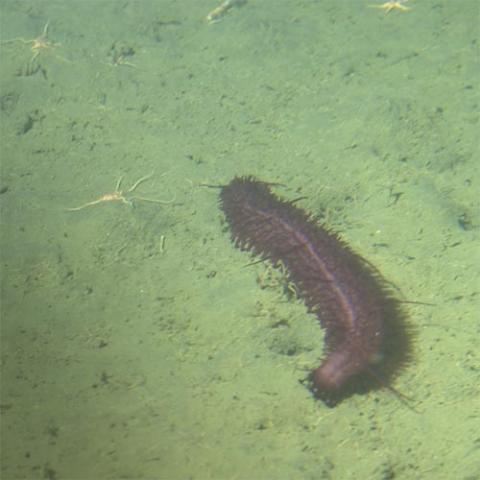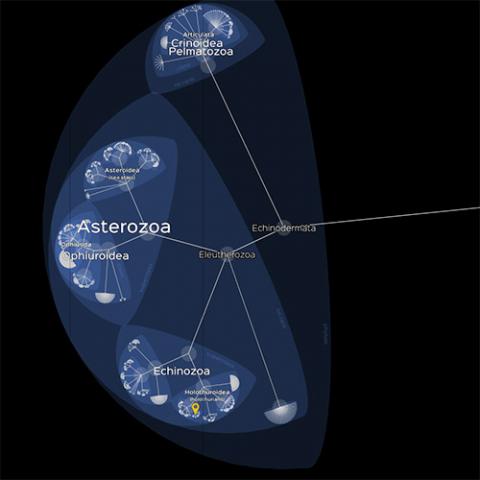NAMES
TAXONOMY
Iceland
Issued:
Stamp:
Laetmogone violacea
Iceland
Issued:
Stamp:
Laetmogone violacea
Iceland
Issued:
Stamp:
Laetmogone violacea
Abstract
Specimens of the holothurians Laetmogone violacea and Benthogone rosea were examined from a number of stations (972 to 2120 m depth) in the Porcupine Seabight and Rockall Trough, N.E. Atlantic. Both species are gonochoric and show an equal division of the sexes. The ovary of Laetmogone violacea is a compact nodose structure containing eggs up to 400 μm diameter. The testis is highly digitate, with the wall of each tubule containing numerous infoldings lined with spermatogonia and spermatocytes; spermatozoa reach a maximum size of 2 μm (head diameter). The ovary of Benthogone rosea consists of thin-walled nodose tubules through which the large egg of 750 μm diameter can be clearly seen. The testis of B.rosea is a small digitate structure, the walls of which lack the infoldings found in L. violacea; spermatozoa have a head diameter of 5 to 7 μm. In neither species is there any evidence for reproductive seasonality.
Reference: Marine Ecology Progress Series
Genus species (Animalia): Laetmogone violacea
Laetmogone violacea (Sea cucumbers) are echinoderms from the class Holothuroidea. They are marine animals with a leathery skin and an elongated body containing a single, branched gonad. Sea cucumbers are found on the sea floor worldwide. The number of holothurian species worldwide is about 1,717 with the greatest number being in the Asia-Pacific region. Many of these are gathered for human consumption and some species are cultivated in aquaculture systems. The harvested product is variously referred to as trepang, namako, bêche-de-mer, or balate. Sea cucumbers serve a useful role in the marine ecosystem as they help recycle nutrients, breaking down detritus and other organic matter, after which bacteria can continue the decomposition process.
Like all echinoderms, sea cucumbers have an endoskeleton just below the skin, calcified structures that are usually reduced to isolated microscopic ossicles (or sclerietes) joined by connective tissue. In some species these can sometimes be enlarged to flattened plates, forming an armor. In pelagic species such as Pelagothuria natatrix (order Elasipodida, family Pelagothuriidae), the skeleton is absent and there is no calcareous ring.
Sea cucumbers are named for their resemblance to the fruit of the cucumber plant.
Overview
Holothurians do not look like other echinoderms at first glance, because of their tubular body, without visible skeleton nor hard appendixes. Furthermore, the fivefold symmetry, classical for echinoderms, although preserved structurally, is doubled here by a bilateral symmetry which makes them look like chordates. However, a central symmetry is still visible in some species through five 'radii', which extend from the mouth to the anus (just like for sea urchins), on which the tube feet are attached. There is thus no "oral" or "aboral" face as for sea stars and other echinoderms, but the animal stands on one of its sides, and this face is called trivium (with three rows of tube feet), while the dorsal face is named bivium. A remarkable feature of these animals is the "catch" collagen that forms their body wall. This can be loosened and tightened at will, and if the animal wants to squeeze through a small gap, it can essentially liquefy its body and pour into the space. To keep itself safe in these crevices and cracks, the sea cucumber will hook up all its collagen fibers to make its body firm again.
Predators and defensive systems
Behavior
Sea cucumbers are often ignored by most of the marine predators because of the toxins they contain (in particular holothurin) and because of their often spectacular defensive systems. However, they remain a prey for some highly specialized predators which are not affected by their toxins, such as the big mollusks Tonna galea and Tonna perdix, which paralyzes them using powerful poison before swallowing them completely. Some other less specialized and opportunist predators can also prey on sea cucumbers sometimes when they cannot find any better food, such as certain species of fish (triggerfish, pufferfish) and crustaceans (crabs, lobsters, hermit crabs).
Some species of coral-reef sea cucumbers within the order Aspidochirotida can defend themselves by expelling their sticky cuvierian tubules (enlargements of the respiratory tree that float freely in the coelom) to entangle potential predators. When startled, these cucumbers may expel some of them through a tear in the wall of the cloaca in an autotomic process known as evisceration. Replacement tubules grow back in one and a half to five weeks, depending on the species. The release of these tubules can also be accompanied by the discharge of a toxic chemical known as holothurin, which has similar properties to soap. This chemical can kill animals in the vicinity and is one more method by which these sedentary animals can defend themselves.
Sea cucumber (Holothuroidea) is one of six orders within the phyla of echinoderms. The graceful sea cucumber depicted on the stamp has been given the name „purple millipede“ (Laetmogone violacea) by the Marine Research Institute. The name refers to its purple color and numerous feet. Sea cucumbers can be found on seabeds all over the world and are widely used for human consumption. One of the largest sea cucumber species in Iceland,Cucumaria frondosa, is the only one used for consumption. Sea cucumbers play an important role in the ocean ecosystem. They break down remnants of dead animals and other organic material while subsisting on plankton and decomposed organic matter.
Reference: www.wopa-plus.com,lifemap-ncbi.univ-lyon1.fr,Wikipedia
Photos: Rauschert, M. and W.E. Arntz
JAMSTEC E-library of Deep-sea Images




